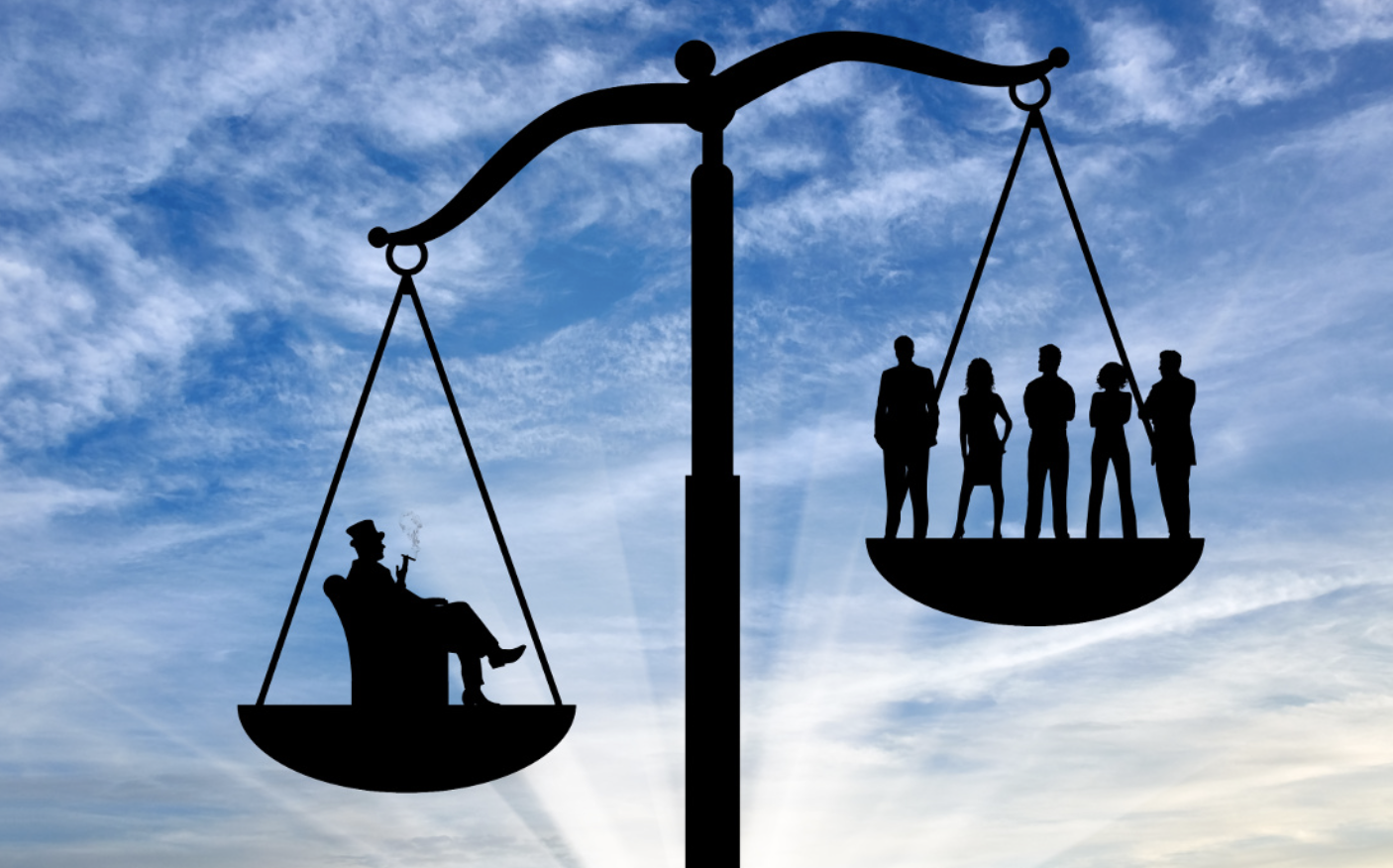私たちが生きるこの世界は、必ずしもすべての人に平等ではありません。家庭環境、経済的な状況、国籍や性別の違い、健康状態など、さまざまな要因によって、子どもたちが置かれる状況や得られる機会には大きな差があります。
しかし、子どもは生まれたときから「平等」「不平等」といった概念を具体的に理解しているわけではありません。そのため、成長の過程で「なぜあの子は同じ年なのに働かなければいけないの?」「どうして私には買ってもらえないものを、あの子は買ってもらえるの?」といった疑問を抱くことがあるでしょう。
そこで親としては、子どもたちが「世の中には不平等がある」という事実に気づき、自分なりに考えられるようにサポートしてあげたいものです。本記事では、親がどのように子どもに“不平等”について伝え、理解を深めてもらうか、そのポイントを紹介します。
1.なぜ「世の中の不平等」を伝える必要があるのか
まず、「世の中の不平等」を伝えることにはどのような意味があるのでしょうか。
- 現実を見据えた視点が育つ
- 大人になってから「こんなはずじゃなかった」とショックを受けるよりも、小さいうちから“不平等”をある程度知っておくことで、社会を見る目が養われやすくなります。
- 「知らなかったからこそ、いざ直面したときに何もできない」という事態を防ぐためにも、子どもが正しい情報と知識を得ることは大切です。
- 他者への共感力や思いやりを育む
- 不平等は、自分よりも恵まれない人がいる一方で、自分のほうが恵まれない場面があることも指します。
- この両面を理解することで、「自分には当たり前にあるものが、他の人にはそうではないかもしれない」「逆に自分が苦しいときには、誰かの助けが必要かもしれない」という相互理解が生まれ、共感力が育っていきます。
- 社会問題に目を向けるきっかけになる
- 貧困問題、人種差別、教育格差、障がいを持つ人々へのサポート不足など、不平等はさまざまな形で存在します。
- 子どもがそうした問題に気づき、「自分にできることは何だろう」と考えるきっかけになれば、それは将来の行動へとつながります。
2.どのタイミングで教えるべきか
世の中の不平等を伝えるタイミングは一概には言えませんが、目安となる状況や子どもの疑問が湧いたときがチャンスです。
- 子ども自身が疑問を口にしたとき
- 「どうしてあの子はランドセルを買ってもらえないの?」「なんであの人は家がないの?」など、子どもが不思議に思うことが出てきたら、まずは親が耳を傾けましょう。
- その上で、無理のない範囲で“不平等”の背景や事情を説明してあげると、子どもの理解が進みやすくなります。
- ニュースや身近な出来事をきっかけに
- 地震や台風などの災害時に被害を受けた地域が支援を必要としているニュース、海外で貧困問題に苦しんでいる子どもたちの話、学校でのいじめや差別といった事柄も入り口になり得ます。
- 一緒にテレビを見ているときに子どもが興味を示したら、「どう思う?」と尋ね、一緒に考える時間をつくってみましょう。
3.子どもに不安を与えすぎないための工夫
「不平等」は時にショッキングな話題です。子どもが「怖い」「悲しい」「自分はどうなるの?」と不安を抱きすぎないよう、話すときの工夫が必要です。
- 年齢に応じた言葉選び
- 幼い子どもには、あまりに重い現実をストレートに伝えすぎると混乱や恐怖心を与えてしまうかもしれません。
- 絵本や童話などでやさしく不平等や格差について描いた作品を一緒に読むのも手段の一つです。
- 「かわいそう」で終わらせない
- ただ「恵まれない人がいる」「大変な人がいる」という情報だけで終わると、子どもは「じゃあどうすればいいの?」と不安や無力感を覚えがちです。
- 「いま世界にはこういう助けをしている人たちもいるよ」「あなたが少し募金をするだけでも役に立てるかもしれないよ」といった、前向きな例や行動へつながる道を示すようにしましょう。
- 親自身の姿勢や心情を伝える
- 「こんな問題があるんだって。でも、少しずつでも変えられると思うんだよね」「○○だから難しいけど、私もあなたも、できることを探していきたいよね」というように、親自身の考えや姿勢を正直に示すことも大切です。
- 子どもは親の表情やトーンから、多くを学び取ります。
4.具体的な伝え方・対話例
(1)身近な例から始める
- 兄弟姉妹の間でのおもちゃの取り合い、クラスメイトとのちょっとした格差、スポーツが得意な子と苦手な子など、子どもの世界にも「不平等」は存在します。
- たとえば、「Aちゃんはピアノが上手で表彰されたけど、Bくんは練習する環境がなくて弾けないんだって。これもひとつの不平等なんだよ」と伝えてみると、子どもにも身近に感じられるでしょう。
(2)絵本やドキュメンタリーを一緒に見る
- 世界の子どもたちがどんな暮らしをしているかを紹介するドキュメンタリー、貧困や差別をテーマにした絵本などを活用し、一緒に感想を話し合うと理解が深まります。
- 「この子は毎日何時間も水を運んでいて、学校に行けないんだって。あなたはどう思う?」と問いかけることで、自分との違いに気づきやすくなります。
(3)募金やボランティアを体験してみる
- コンビニやスーパーのレジ横にある募金箱に、小銭を少し入れるだけでも「不平等へのアクション」の一つになります。
- ボランティア活動ができる年齢になったら、地元の清掃活動やチャリティーイベントに親子で参加してみるのもおすすめです。
5.「不平等」は悪いことばかりではない?
不平等というと「悪いこと」「解決しなければならない問題」というイメージが強いかもしれません。もちろん、多くの不平等は改善されるべき課題ですが、同時に「それが生み出す価値」についても考えてみる余地があります。
- 多様性の源になる
- 得意・不得意がある、不利な状況にある人がいる一方で、その人たちが持つ視点やアイデアは社会に新しい風を吹き込むこともあります。
- 「違うこと」「できないこと」から新しい技術や取り組みが生まれる場合もあると伝えると、子どもは“違い”をネガティブだけでは捉えなくなるかもしれません。
- お互いに助け合う心を育てる
- 不平等に気づき、何とかしようとする気持ちは、思いやりや社会的な責任感を育みます。
- 「誰かにとっては難しいことでも、自分なら得意かもしれないし、助けられるかもしれない」という考え方を子どもと共有すると、前向きな発想へとつながります。
6.親が気をつけたい言動
子どもは親の言動をよく見ています。「不平等」を教えるつもりが、逆に差別や偏見を助長してしまう可能性もあるため注意が必要です。
- 「あの人はかわいそう」と決めつけない
- 相手の背景や努力を知らないまま「かわいそう」とだけ言うと、上から目線やステレオタイプな見方を与えてしまうかもしれません。
- 事実を伝えつつ、「そう感じる理由」「どう思うか」を子どもに質問して、自分で考えさせるきっかけを作りましょう。
- 見下す言葉や態度をとらない
- 「あんな場所で暮らすなんて信じられない」などの言葉は、子どもにとって大人の「偏見」を学ぶ機会になってしまいます。
- 子どもが間違った言葉を使ったときは、優しく正してあげることで、対等な目線や尊重の姿勢を育めます。
- 過度に“差”を強調しない
- 「あそこは本当にひどい環境らしい」「かわいそうで仕方がないよね」というように、過度に悲惨さをあおるだけでは恐怖心や拒否感を募らせるかもしれません。
- 大切なのは“差”を知ったうえで「どう考え、どう行動するか」を一緒に考えることです。
まとめ
世の中には、経済的な格差や社会的な差別など、さまざまな“不平等”が存在します。親としては、子どもがその事実を知ってショックを受けることを恐れるかもしれません。しかし、不平等から目を背けるのではなく、正しい情報と柔らかな言葉を使って伝えることで、子どもは「不平等があるなら、どうやって関わればいいのだろう」と前向きに考えるきっかけを得られます。
- 不平等を知ることは、自分が恵まれている部分・そうでない部分を客観的に見つめ直す機会でもあります。
- 子どもが疑問を抱いたら、親は一方的に答えを押し付けるのではなく、一緒に考えたり、小さなアクションを探したりする姿勢を見せてあげましょう。
- 「不平等は悪いもの」と決めつける前に、それが生む可能性や多様性にも目を向けることで、子どもにとっては新しい視点を得るチャンスにもなります。
親子の対話を通じて、子どもが将来、他者を尊重しながら社会をより良くする一歩を踏み出せるよう、日々の会話を大切にしていきたいですね。
Understanding Inequality: How Parents Can Teach Their Children About Life’s Unfair Realities
We all live in a world that is not entirely fair. Each child’s environment, economic situation, nationality, gender, or health can significantly affect the opportunities they have. Yet, children are not born with an understanding of concepts like “fairness” or “inequality.” As they grow, they may start asking questions such as “Why does that child have to work at my age?” or “Why can’t I get what that other kid has?”
As parents, we want to help our children recognize that inequalities exist in the world and support them in thinking about these realities. In this article, we’ll explore how you can explain “inequality” to your child and deepen their understanding in an age-appropriate way.
1. Why Should We Teach Children About Inequality?
- Developing a Realistic View of the World
- If children reach adulthood without knowing that life can be unfair, they may be shocked or unable to cope when they encounter it firsthand.
- Gaining accurate information and knowledge early on can help them be better prepared to deal with social realities.
- Fostering Empathy and Compassion
- Inequality means that some people are less fortunate than we are, and sometimes we’re the ones who need help.
- By understanding both sides of the situation, children learn that what’s normal for them may not be normal for others, and vice versa, thereby enhancing empathy.
- Encouraging Awareness of Social Issues
- Poverty, racial discrimination, educational gaps, and lack of support for people with disabilities are just a few forms of inequality.
- When children become aware of these issues, they might start thinking, “What can I do to help?” which can lead to constructive actions in the future.
2. When Is the Right Time to Teach About Inequality?
There’s no one-size-fits-all answer, but the best time is often when your child naturally shows curiosity or when a relevant event occurs.
- When Your Child Expresses a Question
- If they ask, “Why doesn’t that kid get a new backpack?” or “Why does that person have no home?” listen to them first.
- Then, gently explain the background and reasons behind the situation, to the extent that’s appropriate.
- Using News or Current Events
- Natural disasters, stories of children living in poverty overseas, or local news about bullying and discrimination can serve as starting points.
- If your child shows interest while watching TV, ask, “What do you think?” and discuss it together.
3. Preventing Excessive Anxiety in Children
Talking about inequality can be shocking for kids. You’ll want to be careful so they don’t feel scared, sad, or overly worried.
- Use Age-Appropriate Language
- For very young children, discussing harsh realities too directly can lead to confusion or fear.
- Consider using picture books or stories that gently illustrate the themes of inequality and differences.
- Go Beyond “That’s So Sad”
- Simply saying “There are unfortunate people” or “Some people have it really tough” can leave children feeling helpless.
- Show them positive examples: “There are people helping those in need,” or “Even small donations can make a difference,” so your child knows there are solutions and hopeful actions.
- Share Your Own Feelings and Attitudes
- Say things like, “Yes, it’s a serious problem, but I believe it can change little by little,” or “It’s difficult, but maybe we can find ways to help.”
- Children pick up on your tone of voice and facial expressions more than you might realize.
4. Practical Ways to Talk About Inequality
(1) Start with Everyday Examples
- Inequality exists even in a child’s world: sibling disputes over toys, differences among classmates, and varying athletic abilities.
- For instance, you might say, “Child A is good at piano and got an award, but Child B never had a chance to practice because they don’t have a piano. That’s one example of inequality.”
(2) Read Picture Books or Watch Documentaries Together
- Use documentaries about children around the world or picture books on poverty or discrimination to help your child visualize.
- Ask, “This child spends hours carrying water and can’t attend school. How do you feel about that?”
(3) Try Fundraising or Volunteering
- Even dropping spare change into a donation box at the grocery store is an easy way to take action.
- If they’re old enough, participating in a local cleanup or charity event as a family can be a powerful experience.
5. Is Inequality Always a Bad Thing?
Often, we see inequality as a problem that must be solved. While many forms of inequality do need addressing, there’s also another perspective to consider.
- It Can Spark Diversity
- Different strengths and weaknesses, or disadvantages in one area, may lead to innovation and new perspectives.
- Realizing that “differences” can be a source of creativity can help children avoid viewing inequality only in a negative light.
- It Encourages Helping One Another
- Recognizing inequality motivates us to help, fostering compassion and social responsibility.
- Share with your child the idea that “What’s hard for one person might be easier for someone else, so maybe we can offer help.”
6. Parental Behaviors to Watch Out For
Children observe their parents closely. Be mindful not to unintentionally reinforce stereotypes or prejudices while trying to teach about inequality.
- Avoid Labeling Someone as “Pitiful”
- Without knowing someone’s background or efforts, describing them as “pitiful” can come across as condescending.
- Focus on stating facts and encouraging your child to form their own thoughts and questions.
- Never Look Down on Others
- Comments like “How can people live in such conditions?” can teach kids your biases.
- If your child uses inappropriate language, gently correct them and emphasize treating others with respect.
- Don’t Overemphasize the “Gap”
- Dwelling too much on how dire a situation is may just scare your child.
- It’s more important to learn about the difference, then discuss “What can we do?” together.
Conclusion
Economic disparity, social discrimination—inequality takes many forms. Parents might worry about exposing children to tough realities, but rather than shielding them entirely, sharing age-appropriate information can prompt them to think, “If inequality exists, what can I do?”
- Learning about inequality allows children to recognize both their advantages and their disadvantages.
- When your child has questions, don’t simply hand them a definitive answer; explore possible solutions or small actions you can take together.
- Before labeling inequality as purely negative, consider the potential for new ideas and diversity it may bring.
Through ongoing family discussions, children will grow into adults who respect others and take steps toward creating a better society. Make the most of daily conversations to guide them in that direction.




コメント